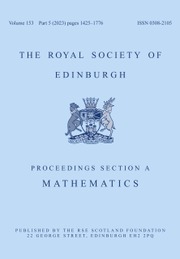In this paper, we consider the following nonlinear Schrödinger equations with the critical Sobolev exponent and mixed nonlinearities:\[\left\{\begin{aligned} & -\Delta u+\lambda u=t|u|^{q-2}u+|u|^{2^{*}-2}u\quad\text{in }\mathbb{R}^{N},\\ & u\in H^{1}(\mathbb{R}^{N}), \end{aligned}\right.\]
where $N\geq 3$ , $t>0$
, $t>0$ , $\lambda >0$
, $\lambda >0$ and $2< q<2^{*}=\frac {2N}{N-2}$
and $2< q<2^{*}=\frac {2N}{N-2}$ . Based on our recent study on the normalized solutions of the above equation in [J. Wei and Y. Wu, Normalized solutions for Schrodinger equations with critical Sobolev exponent and mixed nonlinearities, e-print arXiv:2102.04030[Math.AP].], we prove that
. Based on our recent study on the normalized solutions of the above equation in [J. Wei and Y. Wu, Normalized solutions for Schrodinger equations with critical Sobolev exponent and mixed nonlinearities, e-print arXiv:2102.04030[Math.AP].], we prove that
(1) the above equation has two positive radial solutions for $N=3$ , $2< q<4$
, $2< q<4$ and $t>0$
and $t>0$ sufficiently large, which gives a rigorous proof of the numerical conjecture in [J. Dávila, M. del Pino and I. Guerra. Non-uniqueness of positive ground states of non-linear Schrödinger equations. Proc. Lond. Math. Soc. 106 (2013), 318–344.];
sufficiently large, which gives a rigorous proof of the numerical conjecture in [J. Dávila, M. del Pino and I. Guerra. Non-uniqueness of positive ground states of non-linear Schrödinger equations. Proc. Lond. Math. Soc. 106 (2013), 318–344.];
(2) there exists $t_q^{*}>0$ for $2< q\leq 4$
for $2< q\leq 4$ such that the above equation has ground-states for $t\geq t_q^{*}$
such that the above equation has ground-states for $t\geq t_q^{*}$ in the case of $2< q<4$
in the case of $2< q<4$ and for $t>t_4^{*}$
and for $t>t_4^{*}$ in the case of $q=4$
in the case of $q=4$ , while the above equation has no ground-states for $0< t< t_q^{*}$
, while the above equation has no ground-states for $0< t< t_q^{*}$ for all $2< q\leq 4$
for all $2< q\leq 4$ , which, together with the well-known results on ground-states of the above equation, almost completely solve the existence of ground-states, except for $N=3$
, which, together with the well-known results on ground-states of the above equation, almost completely solve the existence of ground-states, except for $N=3$ , $q=4$
, $q=4$ and $t=t_4^{*}$
and $t=t_4^{*}$ .
.
Moreover, based on the almost completed study on ground-states to the above equation, we introduce a new argument to study the normalized solutions of the above equation to prove that there exists
$0<\overline {t}_{a,q}<+\infty$
for
$2< q<2+\frac {4}{N}$
such that the above equation has no positive normalized solutions for
$t>\overline {t}_{a,q}$
with
$\int _{\mathbb {R}^{N}}|u|^{2}{\rm d}x=a^{2}$
, which, together with our recent study in [J. Wei and Y. Wu, Normalized solutions for Schrodinger equations with critical Sobolev exponent and mixed nonlinearities, e-print arXiv:2102.04030[Math.AP].], gives a completed answer to the open question proposed by Soave in [N. Soave. Normalized ground states for the NLS equation with combined nonlinearities: The Sobolev critical case. J. Funct. Anal. 279 (2020) 108610.]. Finally, as applications of our new argument, we also study the following Schrödinger equation with a partial confinement:
\[\left\{ \begin{aligned} & -\Delta u+\lambda u+(x_1^{2}+x_2^{2})u=|u|^{p-2}u\quad\text{in }\mathbb{R}^{3},\\ & u\in H^{1}(\mathbb{R}^{3}),\quad \int_{\mathbb{R}^{3}}|u|^{2}{\rm d}x=r^{2}, \end{aligned}\right.\]
where
$x=(x_1,x_2,x_3)\in \mathbb {R}^{3}$
,
$\frac {10}{3}< p<6$
,
$r>0$
is a constant and
$(u, \lambda )$
is a pair of unknowns with
$\lambda$
being a Lagrange multiplier. We prove that the above equation has a second positive solution, which is also a mountain-pass solution, for
$r>0$
sufficiently small. This gives a positive answer to the open question proposed by Bellazzini
et al. in [J. Bellazzini, N. Boussaid, L. Jeanjean and N. Visciglia. Existence and Stability of Standing Waves for Supercritical NLS with a Partial Confinement. Commun. Math. Phys. 353 (2017), 229–251].
























































































